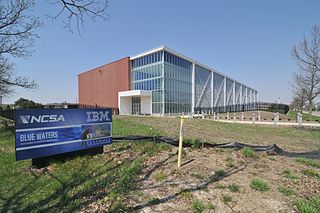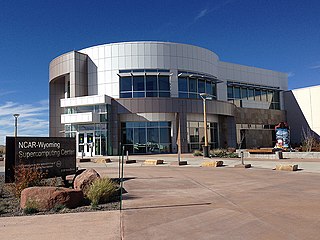 | |
| Operators | USDOE/SC/Argonne National Laboratory |
|---|---|
| Location | Argonne National Laboratory |
| Architecture | IBM BG/Q 5D Torus Interconnect configuration 786,432 cores |
| Power | 3.9 MW |
| Operating system | CNK [1] |
| Space | 1,632 sq feet |
| Memory | 768 TiB |
| Speed | 8.59 petaFLOPS (LINPACK) 10.06 petaFLOPS theoretical peak |
| Ranking | TOP500 : 11, 2017-11 |
| Purpose | Cosmology, Astronomy, lattice quantum chromodynamics, Nuclear reactor engineering, Material science, Weather, Climatology, Seismology, Biology, Computational chemistry, Computer science |
| Legacy | Ranked 3 on TOP500 when built. |
| Web site | www |
Mira is a petascale Blue Gene/Q supercomputer. As of November 2017, it is listed on TOP500 as the 11th fastest supercomputer in the world, [2] while it debuted June 2012 in 3rd place. It has a performance of 8.59 petaflops (LINPACK) and consumes 3.9 MW. [3] The supercomputer was constructed by IBM for Argonne National Laboratory's Argonne Leadership Computing Facility with the support of the United States Department of Energy, and partially funded by the National Science Foundation. [4] Mira will be used for scientific research, including studies in the fields of material science, climatology, seismology, and computational chemistry. [5] The supercomputer is being utilized initially for sixteen projects, selected by the Department of Energy. [6]

A supercomputer is a computer with a high level of performance compared to a general-purpose computer. The performance of a supercomputer is commonly measured in floating-point operations per second (FLOPS) instead of million instructions per second (MIPS). Since 2017, there are supercomputers which can perform up to nearly a hundred quadrillion FLOPS. Since November 2017, all of the world's fastest 500 supercomputers run Linux-based operating systems. Additional research is being conducted in China, the United States, the European Union, Taiwan and Japan to build even faster, more powerful and more technologically superior exascale supercomputers.

The TOP500 project ranks and details the 500 most powerful non-distributed computer systems in the world. The project was started in 1993 and publishes an updated list of the supercomputers twice a year. The first of these updates always coincides with the International Supercomputing Conference in June, and the second is presented at the ACM/IEEE Supercomputing Conference in November. The project aims to provide a reliable basis for tracking and detecting trends in high-performance computing and bases rankings on HPL, a portable implementation of the high-performance LINPACK benchmark written in Fortran for distributed-memory computers.
LINPACK is a software library for performing numerical linear algebra on digital computers. It was written in Fortran by Jack Dongarra, Jim Bunch, Cleve Moler, and Gilbert Stewart, and was intended for use on supercomputers in the 1970s and early 1980s. It has been largely superseded by LAPACK, which runs more efficiently on modern architectures.
Contents
The Argonne Leadership Computing Facility, which commissioned the supercomputer, was established by the America COMPETES Act, signed by President Bush in 2007, and President Obama in 2011. [5] The United States' emphasis on supercomputing has been seen as a response to China's progress in the field. China's Tianhe-1A, located at the Tianjin National Supercomputer Center, was ranked the most powerful supercomputer in the world from October 2010 to June 2011. [4] Mira is, along with IBM Sequoia and Blue Waters, one of three American petascale supercomputers deployed in 2012. [4] The cost for building Mira has not been released by IBM. Early reports estimated that construction would cost US$50 million, [7] and Argonne National Laboratory announced that Mira was bought using money from a grant of US$180 million. [4] In a press release, IBM marketed the supercomputer's speed, claiming that "if every man, woman and child in the United States performed one calculation each second, it would take them almost a year to do as many calculations as Mira will do in one second". [8]
The America Creating Opportunities to Meaningfully Promote Excellence in Technology, Education, and Science Act of 2007 or America COMPETES Act was authored by Bart Gordon and signed by President George W. Bush; it became law on 9 August 2007. This was an Act, "To invest in innovation through research and development, and to improve the competitiveness of the United States."

George Walker Bush is an American politician and businessman who served as the 43rd president of the United States from 2001 to 2009. He had previously served as the 46th governor of Texas from 1995 to 2000.

Barack Hussein Obama II is an American attorney and politician who served as the 44th president of the United States from 2009 to 2017. A member of the Democratic Party, he was the first African American to be elected to the presidency. He previously served as a U.S. senator from Illinois from 2005 to 2008.












